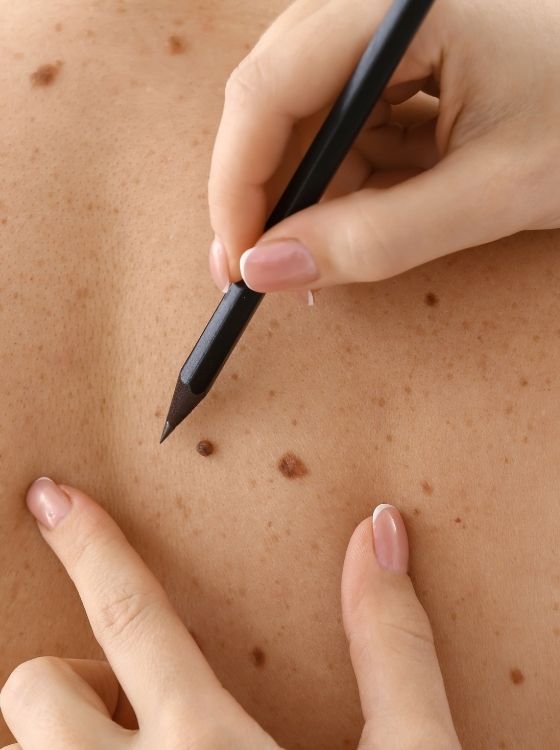Surgical Procedures
Here at Dermatology Center of Atlanta, we perform a myriad of common skin surgical procedures.
Common Skin Surgical Procedures
Dermatologists routinely perform skin surgery for a variety of reasons. Surgical procedures on the skin can usually be done with local anesthesia (numbing medicine). Continue reading to learn more about common surgical procedures performed by dermatology professionals.
Wound closure
Surgical wound closure is done to speed up healing, protect underlying tissues, and improve appearance (by hiding scars as much as possible). It can be achieved with primary closure using sutures (dissolvable or non-dissolvable stitches) to approximate the edges of the wound. Alternatively, your dermatologist can perform a skin graft, where some skin is removed from a donor site and used to patch up the wound.
Earlobe repair
Wearing heavy earrings for prolonged periods can lead to the widening of the ear-piercing holes. Split earlobes can occur as a result of trauma, such as if an earring is pulled forcefully through the piercing hole by a small child or pet. Sometimes, tight clip-on earrings can cause restricted blood flow and tissue death in the earlobe.
These problems can be corrected by a dermatologist using a surgical technique, in which the split or widened hole is stitched back together using special suture material. It is an outpatient procedure, and you can go home the same day. You will need to return to the clinic, however, in a few days for suture removal.
Skin biopsies
A skin biopsy is a procedure in which a small sample of skin is taken for evaluation under the microscope. It is done to aid in diagnosing skin conditions with clues that are not visible to the naked eye. The biopsy is usually taken using a local anesthetic. There are different types of skin biopsies, such as a punch biopsy for a full-thickness sample of skin, a shave biopsy for a superficial lesion, an incisional biopsy to remove larger and deeper portions of skin (this typically requires wound closure with stitches), or an excisional biopsy for complete removal of a skin lesion, such as skin cancer.
Cyst excision
A cyst is a sac-like structure that contains fluid, pus, or other substances. Various types of cysts can grow underneath the skin, including epidermal inclusion cysts and sebaceous cysts. Some cysts can be left alone; however, others need to be removed if they are getting larger and causing symptoms such as pain or have become infected. Sometimes, your dermatologist may recommend cyst excision (removal) to make sure it is not cancer.
The cyst excision procedure involves making a cut around the cyst and removing the sac, complete with its walls and contents. Your dermatologist will then clean the wound and close it with stitches. Sometimes, a drain is left in place to remove any remaining fluid. Finally, the wound is bandaged, and you will be asked to keep it clean and dry until it is fully healed.

Award Winning
We are an award winning dermatology practice that specializes skin.

Experience
Our expert medical providers have years of training and hands-on experience.

Integrated Care
We offer multiple dermatology providers and departments.

Entire Family
We can address dermatology concerns for the entire family at DCA.

Mole removal
Surgical removal of a mole may be necessary if the mole is cancerous or for cosmetic reasons. Dermatologists can remove a mole during an office visit with either a shave excision or a surgical excision. During a shave excision, your dermatologist will use a blade to carefully remove the mole. Sometimes, a tiny electrode may be used to feather the mole electrosurgically and blend the edges of the wound with the surrounding skin. No stitches are required after a shave excision.
Another way to remove a mole is through surgical excision. This is a deeper procedure and involves cutting out the mole entirely. Due to the type of excision, stitches are generally needed to close the incision.
Moles are usually sent to the laboratory after removal to check for cancer. The healing time after mole removal depends on the size of the wound. In general, it takes 2-3 weeks for the wound to heal, and your dermatology provider will advise you on the things you can do to reduce scarring.
Skin tag removal
Skin tags are very common and usually harmless outgrowths of skin that frequently develop on the neck, underarms, below the breasts, and in the groin area. While they do not cause any health problems, skin tags can appear unsightly or be annoying if located where you shave, which can cause pain and bleeding. Skin tags near the eyes may need to be removed if they are large enough to cause vision problems.
Your dermatologist can remove one or more skin tags by freezing them off with liquid nitrogen (this is known as cryosurgery). Skin tags can also be removed with electrosurgery (burning the skin tag with an electrical current). Ligation (tying off the skin tag with a surgical thread) to cut off its blood supply is another way to treat it. Lastly, dermatologists can perform surgical excision of skin tags with a pair of sterile scissors or scalpel. Small skin tags can often be removed without anesthesia – larger ones may require local anesthesia. It is not recommended that you try to remove skin tags at home as there is a high risk of infection.
Skin cancer treatments and surgery
Dermatologists can use various procedures to remove skin cancers, some of which are briefly described below:
Electrodesiccation and curettage: This is an outpatient procedure in which the skin is numbed with local anesthetic. The cancer cells are then scraped off with a scoop-like tool called a curette. The dermatologist then applies an electrical current to the wound to stop bleeding. No stitches are needed. The wound is bandaged, and you can go home. The treatment can leave a small scar. Electrodesiccation and curettage are appropriate for small skin cancers that have not invaded below the top layer of skin. This treatment cannot be performed near sensitive areas such as the lips or eyes. Also, the tissue is destroyed and cannot be checked in the laboratory to ensure all the cancer was removed.
Surgical excision: In this procedure, the dermatologist removes the entire skin cancer along with a border of healthy skin tissue. It is done using a local anesthetic. The incision is closed with stitches, and you can go home after the procedure, but you must return to the clinic for suture removal after 1-2 weeks.
Mohs surgery: This is a highly specialized procedure for skin cancer removal and reconstruction in which the cancer is removed layer by layer along with a border of healthy cells. Your dermatology provider may ask you to wait while they check the tissue to ensure the cancer has been removed completely. If not, you may need to undergo another round of surgery, so the entire process can take several hours. Only a small border of healthy tissue needs to be taken during Mohs surgery, minimizing the risk of scarring. Mohs surgery leaves the smallest possible scar, and it is therefore used to remove skin cancers from areas such as the face or ears.
our dermatology
Credentials










